A Calm Book for a Mad Time: Inherit The Stars by James P. Hogan
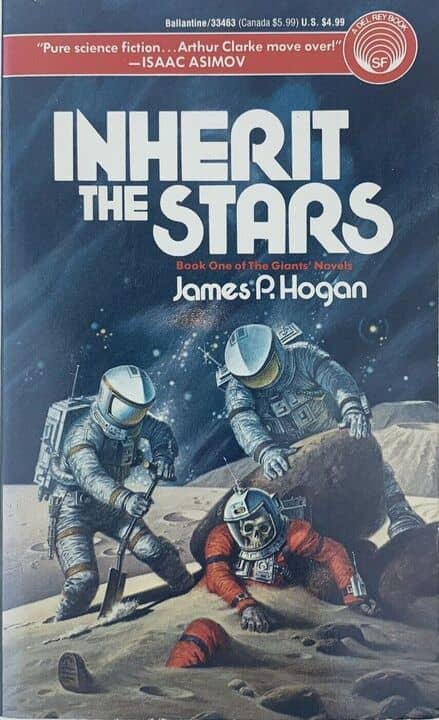 |
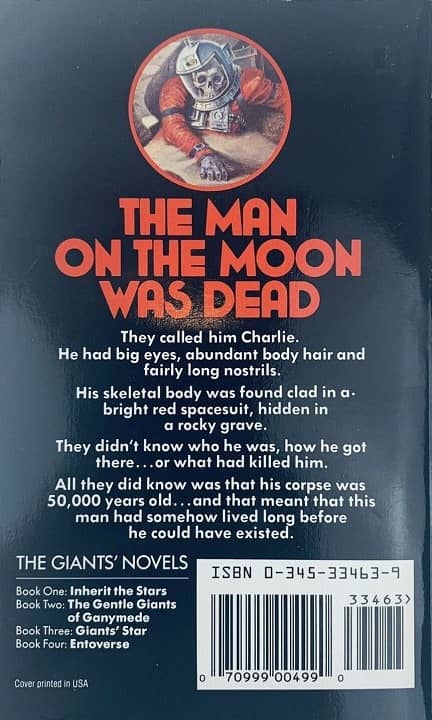 |
Inherit the Stars (Del Rey, 1990 reprint). Cover art by Darrell K. Sweet
James P. Hogan’s Giant’s Trilogy has been a presence at my parents’ house since the late 70s. Sometimes on the shelf, sometimes on the coffee table, sometimes on the end table. I had to move my mom into assisted living last year and in sorting the books (oh, the books!) into ‘take with her,’ ‘move on,’ and ‘keep for myself,’ I gently slipped them into the ‘keep for myself’ pile, and now, two years later, I have started to read them.
Inherit the Stars is very much a book of its time, and its time is 1976. My views are split: the ideas that make up the book are very good, but the actual story? Dull. There is no real tension, no villain (more on this later), no real action. Nobody’s spacesuit ruptures, nobody’s virgin-launch spaceship has a glitch. This is a book about ideas and that’s it. I sometimes got an image in my mind of Isaac Asimov reading Inherit the Stars and having to light up a post-idea cigarette.
As frequent readers of my reviews will know, I have very little desire to write spoiler-free reviews of 44-year-old books. New readers, be warned.
[Click the images for Giant versions.]
The book is best approached as a mystery. The mystery is that in 2027 A dead man is found on the moon, his spacesuit is nothing like those used by the UNSA and after a short bit of research it is clear he’s been there for 50,000 years. The corpse is nicknamed Charlie, and the mystery of the book is who the heck is he, how the heck did he get here, and why is there no evidence of a 50K year-old high-tech human civilization on Earth or anywhere else in the solar system?
Not long after Charlie’s discovery, in a remarkably lucky break, we also discover the wreck of an alien spacecraft frozen in the ice of the Jovian moon Ganymede. It is 5 million years old, and full of samples of animals from Earth — including pre-human primates. The aliens that built the ship are 8-feet tall humanoid beings immediately dubbed “Ganymeans,” or “the giants.”
The Giants Trilogy by James P. Hogan: Inherit the Stars (1977), The Gentle Giants of Ganymede (1978), and Giants’ Star
(1981). Del Rey paperback editions, covers by Darrell K. Sweet, H. R. Van Dongen, and Darrell K. Sweet
The book is about unthreading the mysteries of who the corpse on the moon is, who the aliens are, and if, even though the two are separated by 5 million years, they are somehow related.
The people who discover the body and the spaceship begin studying it and the artifacts around it, moving qualified personnel onto the project, and bringing in outside experts, devoting personnel and resources to it. Everyone is calm, reasonable, and passionate, (but not crazy). Humanity in 2027 has left behind war and greed and has zero interest in bringing any of that back. Thus, no shadowy cabal of techno-racists-end-timers tries to get Charlie-level technology. There is no showdown between the groups studying Charlie and the groups studying the Ganymean spaceship.
Human Characters
Gregg Caldwell — Head of the UN Space Administration
Lyn Garland — Caldwell’s girl-Friday
Victor Hunt — Electrical Engineer tapped by Caldwell to head the team tasked with unraveling the Charlie mystery.
Christian Danchekker — Top notch biologist, old school academic, a high-ranking member of the team.
You know the trope of meeting a gamer and he/she is all “Let me tell you about my character?” This book is basically Hogan saying “Let me tell you about my world building.” This is weirdly refreshing! I know that sounds odd, but it is true. The book is a product of its time and my impressions of it were a product of the waning mad days of fall 2020*. Honestly, it was nice to take a break, even a fictional one from the chaos and stupidity of the world!
If there is any enemy at all it is orthodoxy (and you have to imagine some old crank shaking his fist every time you read the word ‘orthodoxy’). For the most part, Christian Dancheckker is the main voice of orthodoxy [fist shaking], because he is constantly having to remind people that ‘evolution doesn’t work that way.’ And he’s right! It doesn’t!
Back covers to The Giants Trilogy
The mystery deepens with the discovery that the dark side of the moon is not nearly the same as the light side, as if it was bombarded by several million metric tons of asteroids and debris.
Using carbon dating and a variety of sciences and studies, the team begins to unthread the story of Charlie and his people. A breakthrough is that Charlie is carrying a tin of preserved fish and with genetic studies and some physiological observation, it is discovered that these fish are not from Earth. Furthermore, just as you can prove that modern homo sapiens evolved from a fish-like ancestor, the giants on the Ganamydian ship are distantly related to Charlie’s preserved fish.
The history unfolds that there was a tenth planet between Mars and Jupiter, which we name Minerva, and this is the home of the giants. Based on what can be gleaned from the Ganymedian ship, the giants are stunningly peaceful, but their world was changing, CO2 levels were rising and outside of the climate issues (and remember, the idea of climate change, of global warming, was a big deal in the early 70s. Cutting Edge Stuff), CO2 is particularly poisonous to Minervan life.
Maybe the giants of 5 million years ago were searching for a new home on Earth, or studying Earth to see how Minerva’s sister planet deals with being so much closer to the sun, or maybe they were bringing Earth animals to Minerva as a massive geoengineering project?
Whether on purpose or by design, Earth life gets loose on Minerva, quickly outcompeting the local lifeforms, and, it would appear, making an already difficult situation much worse. Evolution continues on Minerva, just as it does on Earth and Charlie is descended from the primates brought from Earth to Minerva.
In an odd reflection of the mid 70s, the humans of Minerva (always called Lunarians, because that is where the Charlie is discovered) are split into two camps, a semi-freedom loving group, and a militaristic command-and-control group. War is certain! War happens!
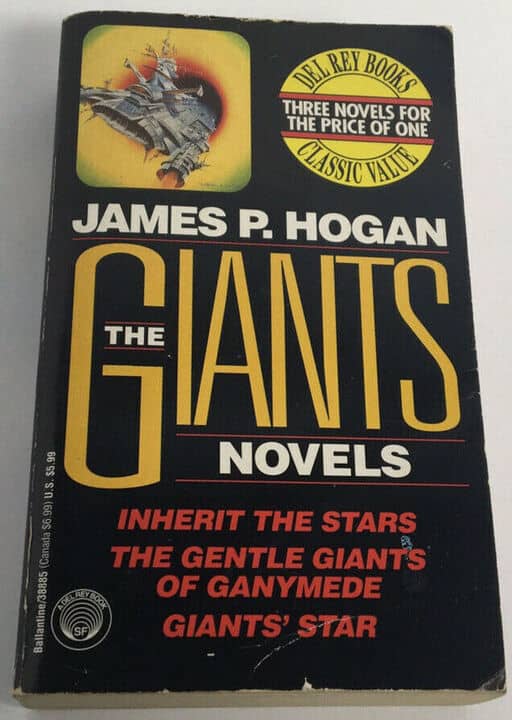 |
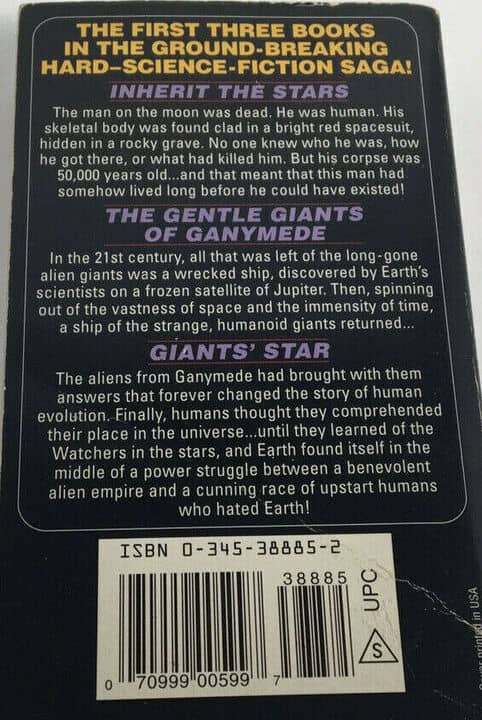 |
The Giants Novels (Del Rey omnibus edition, 1994). Cover by Darrell K. Sweet
And, let me remind you, it is the researchers on Earth who are theorizing about that war. There are no flashbacks to the war itself — the closest we get to that is the Epilogue at the start of the book where Charlie is, well, about to die on the moon.
The translations from Charlie’s journal reveal a soldier trapped in the horrible exchange between the two nations. His group is ordered to take over hostile bases on Minerva’s moon and from there he sees the destruction of Minerva in an exchange of nucleanic bombs (like nuclear bombs, but bigger. Like a nuclear bomb to a nuclear bomb).
Charlie’s journal makes no sense, as he is found Earth’s moon, but he states that he can clearly see Minerva.
As sometimes happens in mid-70s science-fiction, there are some loving asides into the tech:
The stream of data taken in by the cameras flashed back to preprocessors in the low-level control room, and from there via cable to the surface of Ganymede. After encoding by the computers in the Site Operations Control building, it was relayed by microwave repeaters seven hundred miles to Ganymede Main Base, restored to full strength, and redirected up to the orbiting command ship. Here, the message was fed into the message exchange and scheduling processor complex, transformed into high-power laser modulations, and slotted into the main outgoing signal beam to Earth. For over an hour the data streaked across the Solar System, covering 186,000 miles every second, until t he sensors of the long-range relay beacon, standing in Solar orbit not many million miles outside of Mars, fished it out of the void, a microscopic fraction of its original power. Retransmission from here found the Deep Space Link Station, lodged in Trojan equilibrium with Earth and Luna, and eventually a synchronous communication satellite hanging high over the central USA, which beamed it down to a ground station near San Antonia. A landline network completed the journey to UNSA Mission Control, Galveston, where the information was greedily consumed by the computers of Operation Command Headquarters.
Whew! Hogan does this at least half a dozen times! You can take the man out of electronics engineering, but you can’t take the electronic engineering out of the man!
As also often happens in mid-70s science fiction, the ladies get short shrift. There are women, women pilots, women scientist, but they aren’t main characters. That said, there is one delightful part of the book where Hunt and Danchecker and the team are trying to decode one of the items in Charlie’s pack and they are stumped. It kind of looks like the periodic table of elements; but it also kind of look like a table of conversions; but it also seems to be written in code. Hogan spends a lot of time on this before having Lyn Garland, walks in, glance at it, and say “Oh, I see you found Charlie’s calendar.”
What is the answer the riddle of Charlie’s inexplicable journal entries? The sin of orthodoxy! Earth’s moon is not, in fact, Earth’s moon, it is the moon of Minerva. Minerva breaks up upon the nucleic weapons exchange, shedding its out outer layers to become the asteroid belt, while it’s small sad core drifts outward to become Pluto. It’s moon, however, drifted inward, to be captured by Earth about 50,000 years ago.
If that seems odd to you that’s because it is. It is incredibly odd. Where did Hogan come up with that?
That’s where things get weird.
So, there is this old-school crank, Immanuel Velikovsky, who had this mad theory that because Greek myth said that Venus was birthed from Jupiter’s forehead, the planet Venus must have come out of the planet Jupiter. He wrote it all up in a book called Worlds in Collision.
If you’re a person of a certain age that mad bit of crankery may sound vaguely familiar. Why? Because Carl Sagan walked us through it in an odd tangent in episode four of Cosmos.
Back to Inherit the Stars. James Hogan handles the Velkikovsky crankery very delicately, and it is hard to tell when he goes from talking about the real science and research (of the mid-70s) to the crazier stuff — a remarkable bit of literary slight-of-hand.
For all the lack of action and the incredibly peaceful societies of Earth and the Ganymedeans, the book does end in a weird vibe. That being the ‘man-the-conqueror, man-the-hunter, sharpened by the Miranda wars, and the struggle for survival on a Pleistocene Earth, to become man-the-conqueror man-the-space-hunter.”
My final word? If, in these troubled times, you are looking for a book where reasonable people reasonably dissect and solve a mystery, while simultaneously wanting that mystery to be based on something as completely unreasonable as Velkovsky’s pseudo-science “theories,” then Inherit the Stars should be on your list!
Adrian Simmons is an editor for Heroic Fantasy Quarterly, check out their Best-of Volume 3 Anthology, or support them on Patreon!
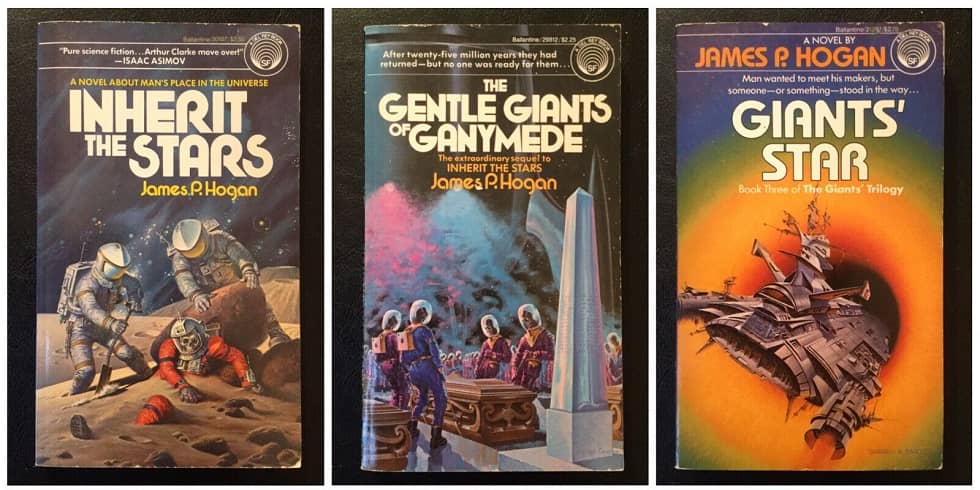
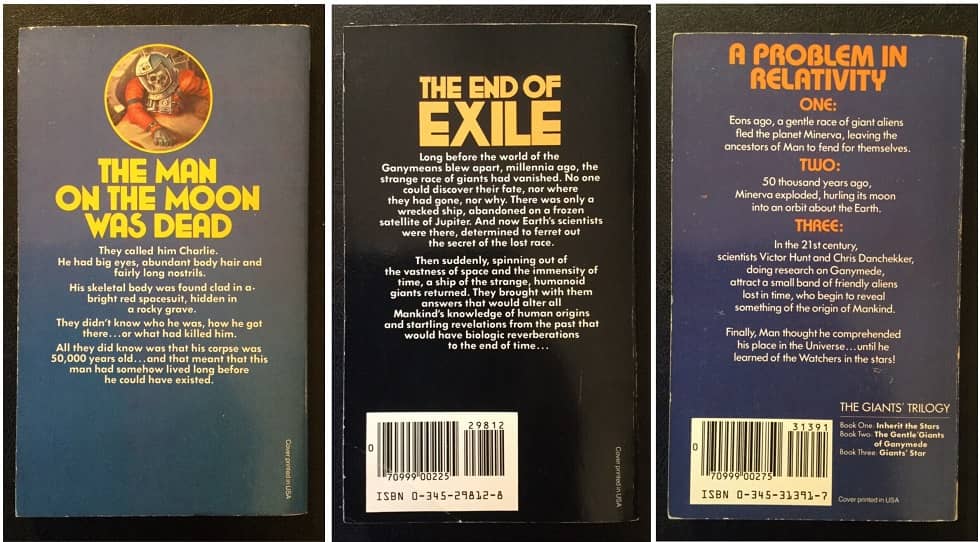
This sounded really interesting, but unfortunately I wikipedia searched the author, which I recommend you don’t do unless you’ve settled the question of separting art from the artist better than I have!
Oh yeah. Maybe I should have put a ‘don’t wikipedia any of this’ warning into the review! Don’t give away anything that I’m going to put in the review of “The Gentle Giants of Ganymede”!
I read the first one some decades ago and remember finding it just the way you describe it. That DK Sweet cover of Inherit the Stars is definitely an important part of my childhood scifi mindscape
Yes, the DK Sweet cover is a big part of the appeal of this book. Since it has been in my parents house since the late 70s, his cover has been a big part of my childhood scifi mindscape!
Same here. I read the first volume when it was published the 70s, but I don’t think I ever got around to reading any of the other books in the series. And that DKS cover is awesome. It was one of the things that made me pick the book up in the first place.
The cover really sells it! I’ll be reviewing the other books eventually.
You have my attention, and I may try to find this one soon.
What’s the asterisk for?
I think it led to a footnote saying “As opposed to the mad days of Spring 2021, as I write this”, but I think I managed to cut it in the final push.
I only read inherit the stars – the other two books did not grab me and the authors Voyage to Yesteryear was just bad. I enjoyed Inherit the Stars though but as you say it had no real antagonist which gave it a somewhat unfinished feel.
The other two books have their strengths, but I think the first one is the best. I think there may even be more than 3 in the series, but I haven’t investigated very deeply on it.
Yes, if you look at the back cover of the 1990 edition of Inherit the Stars, you find that there is a 4th book in the “trilogy” (pace, Douglas Adams!), Entoverse, which was published in 1991. And there was also a 5th book, Mission to Minerva that came out in 2005.
I read all 3 of the original trilogy and enjoyed them for what they were. Though I started Entoverse, but it seems that the author had a culture shift in his real life world views and it was reflected in that book. I could not get through it, mostly because it seemed to be ruining what I liked about the original.
Never read it and I’m glad, as I need more than ideas in a novel, but that’s one heck of an opening idea.
I just read this book, and didn’t find it dull at all. I enjoyed all the discussions between the scientists, and found the lack of “action” (violence, intrigue, etc.) refreshing.